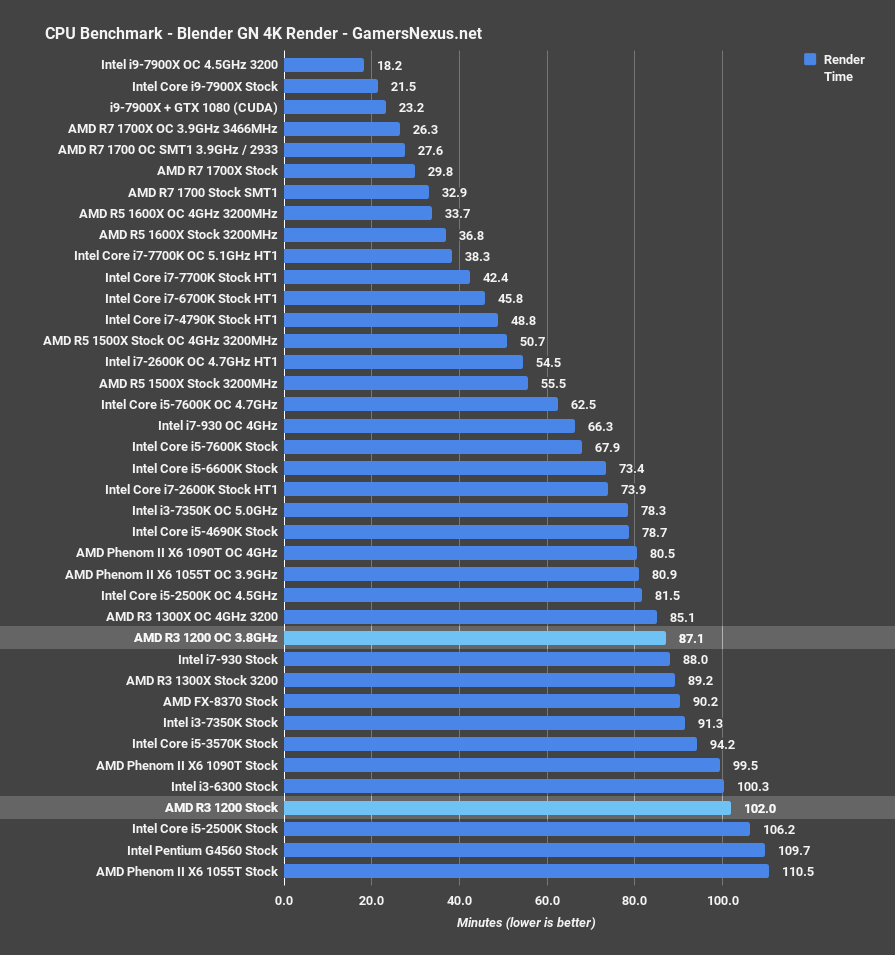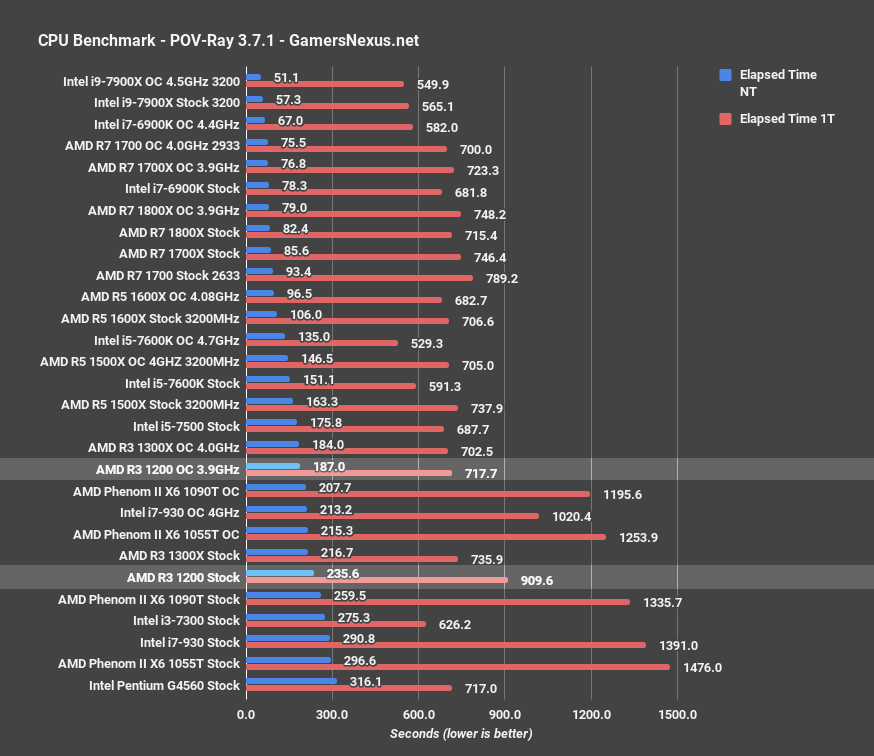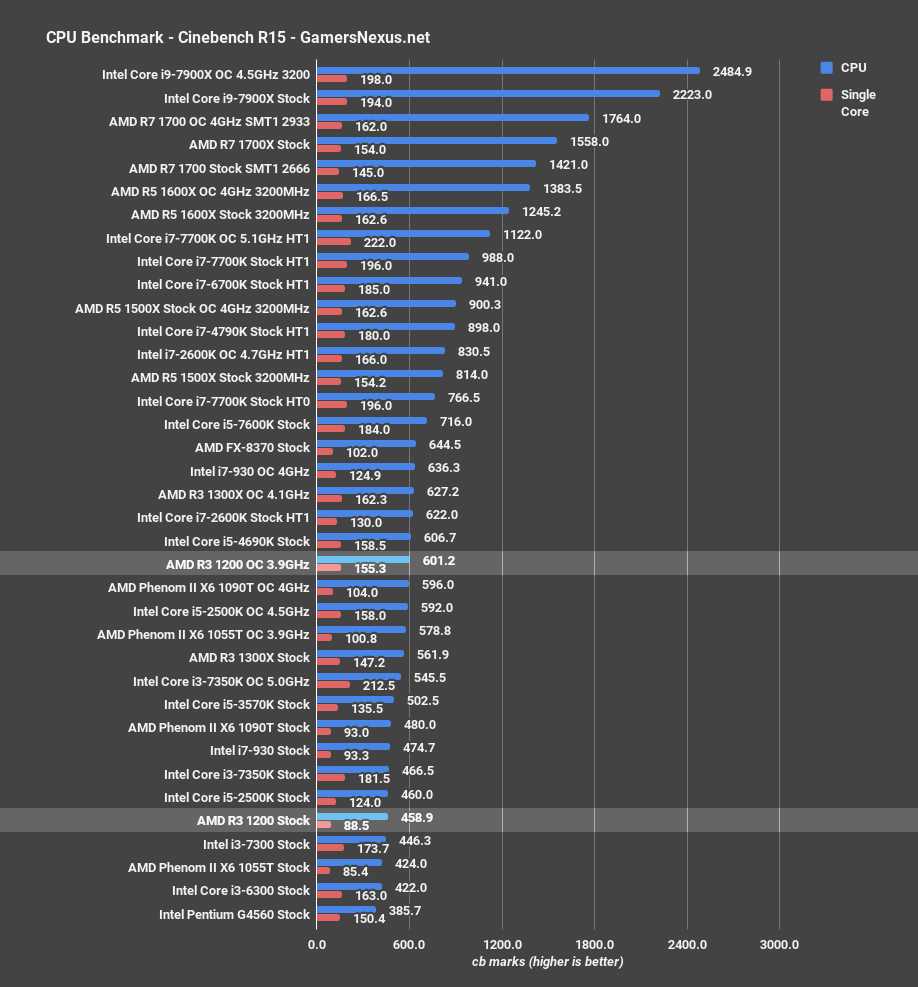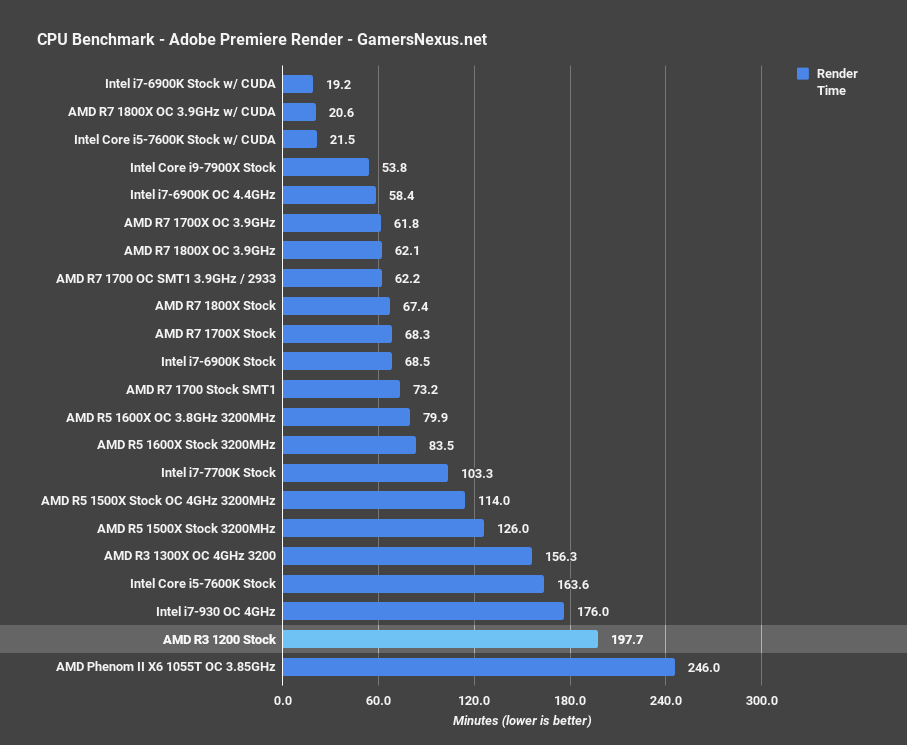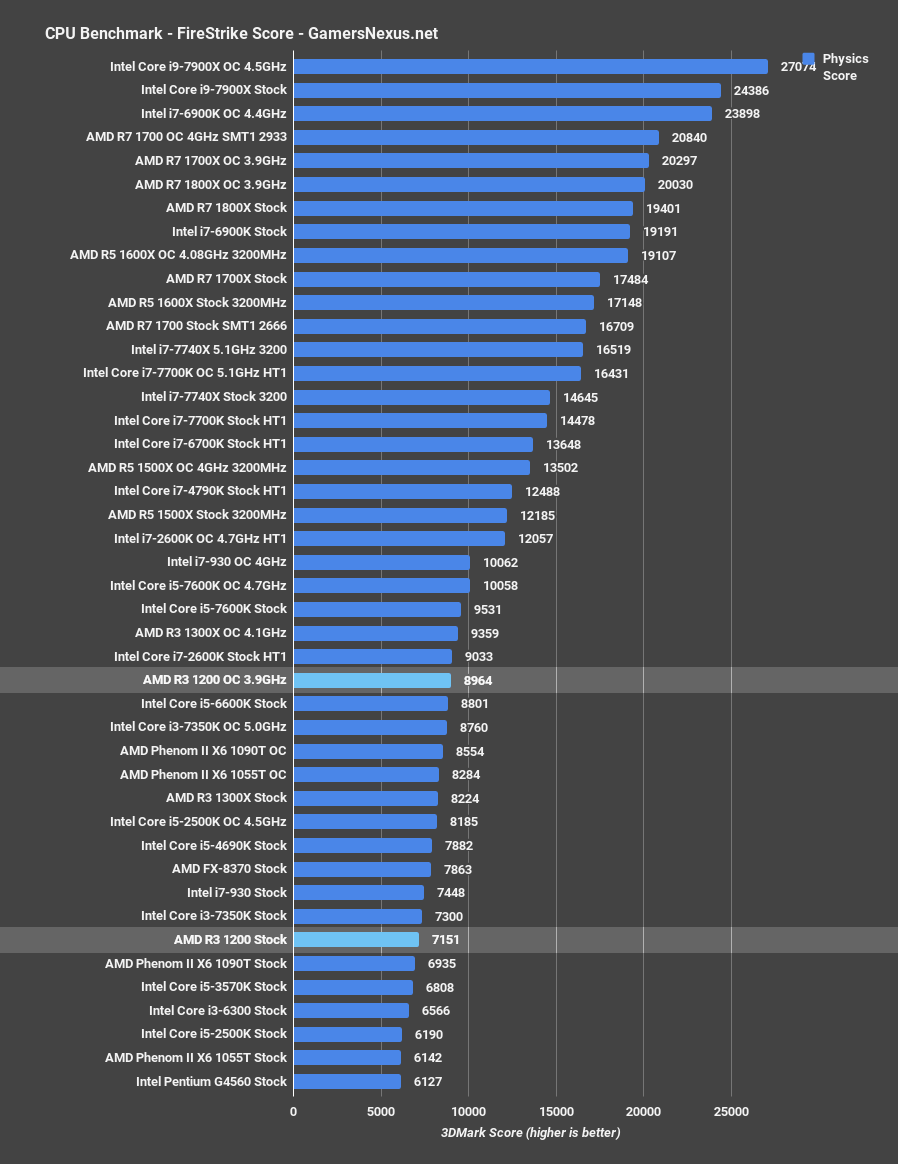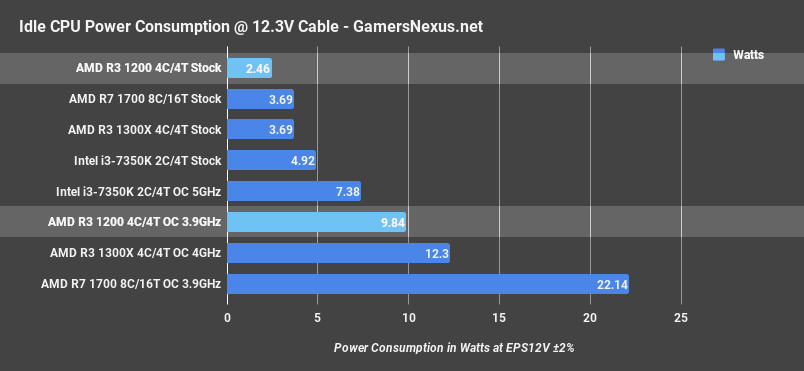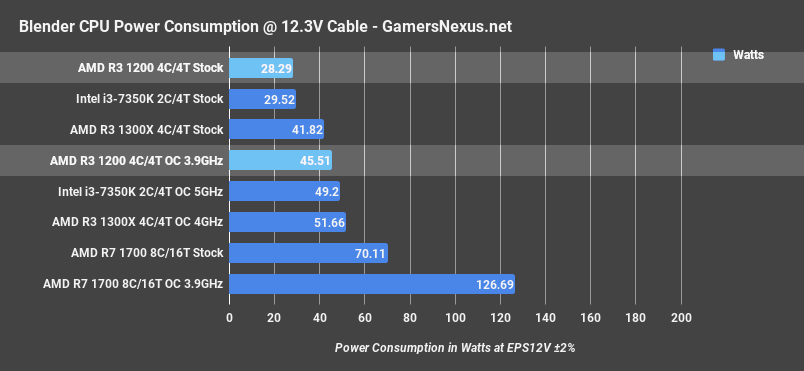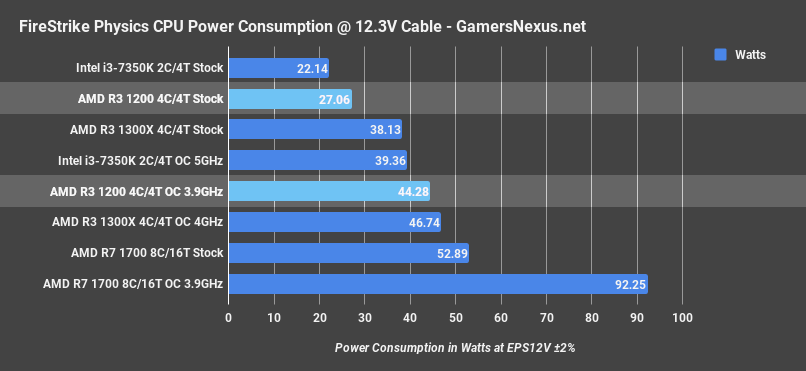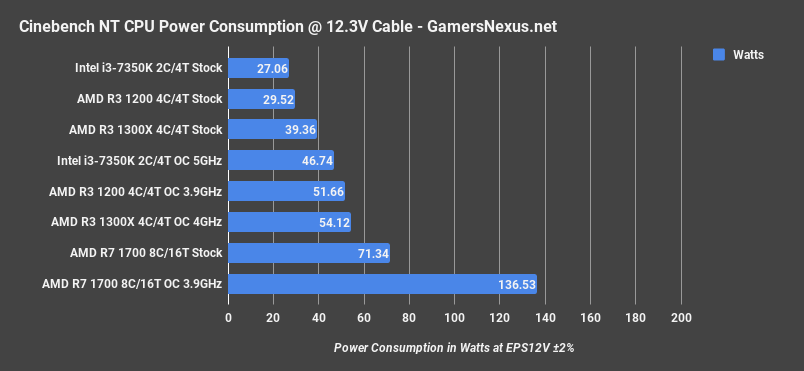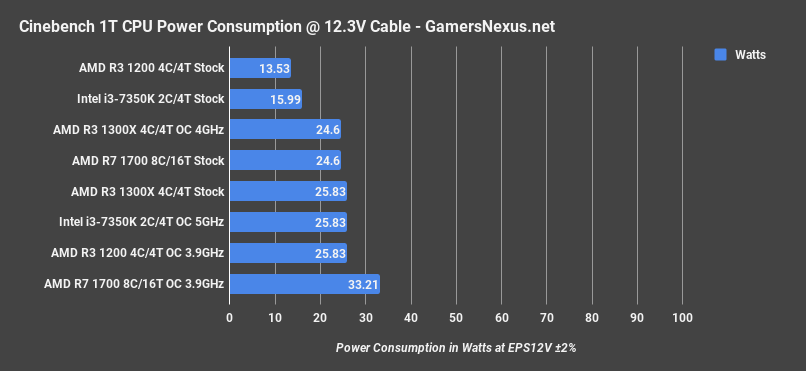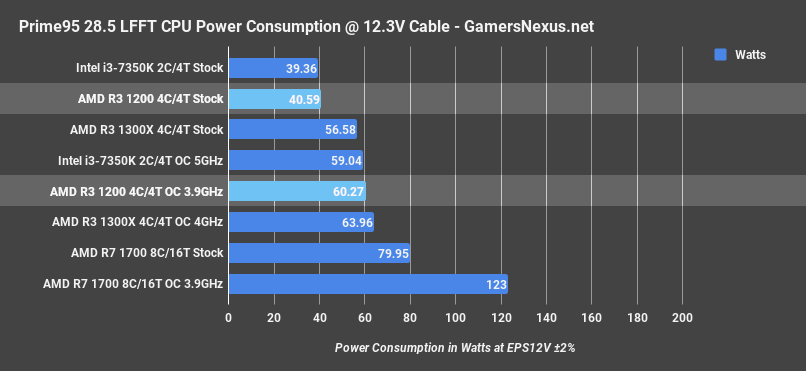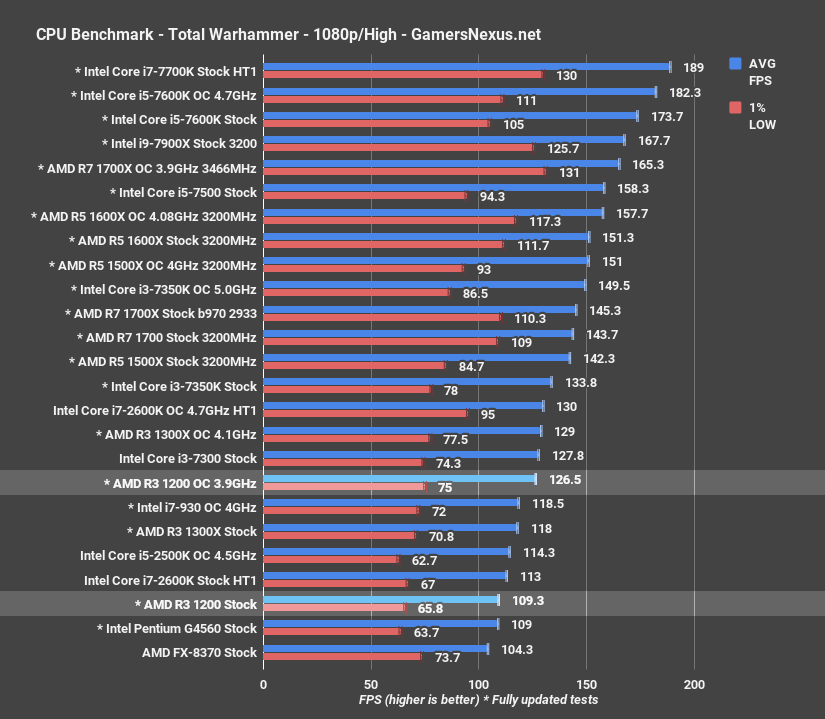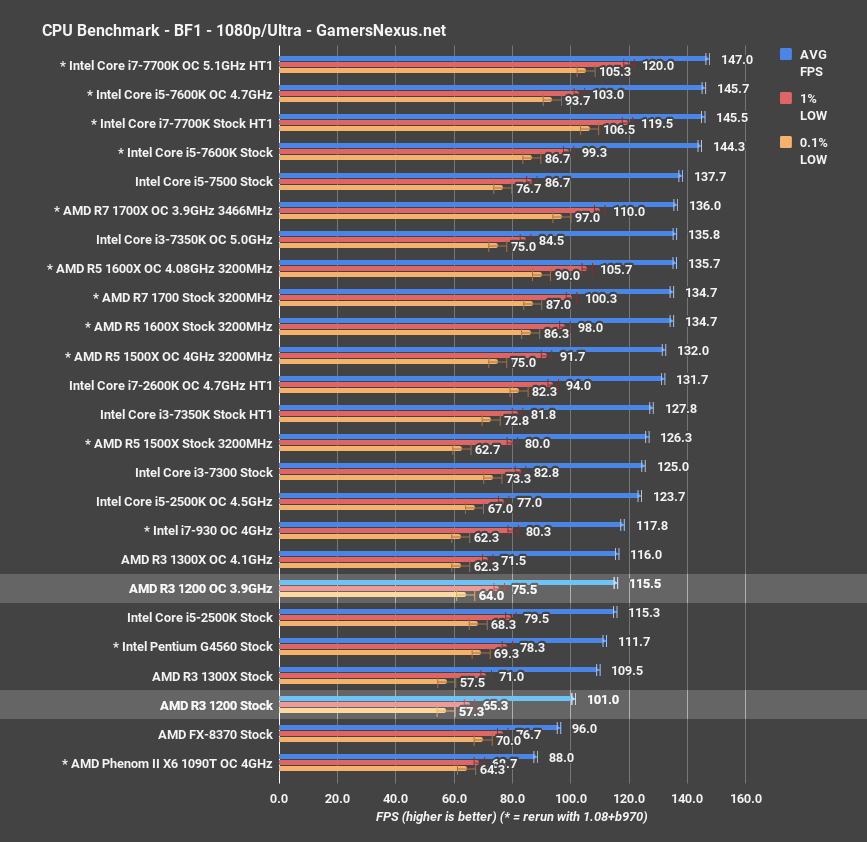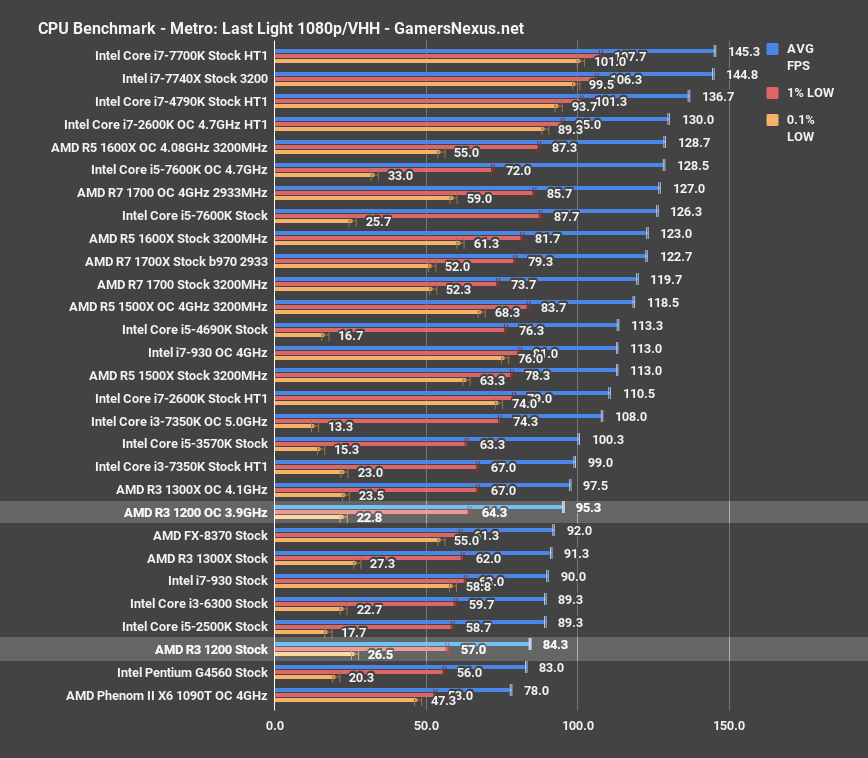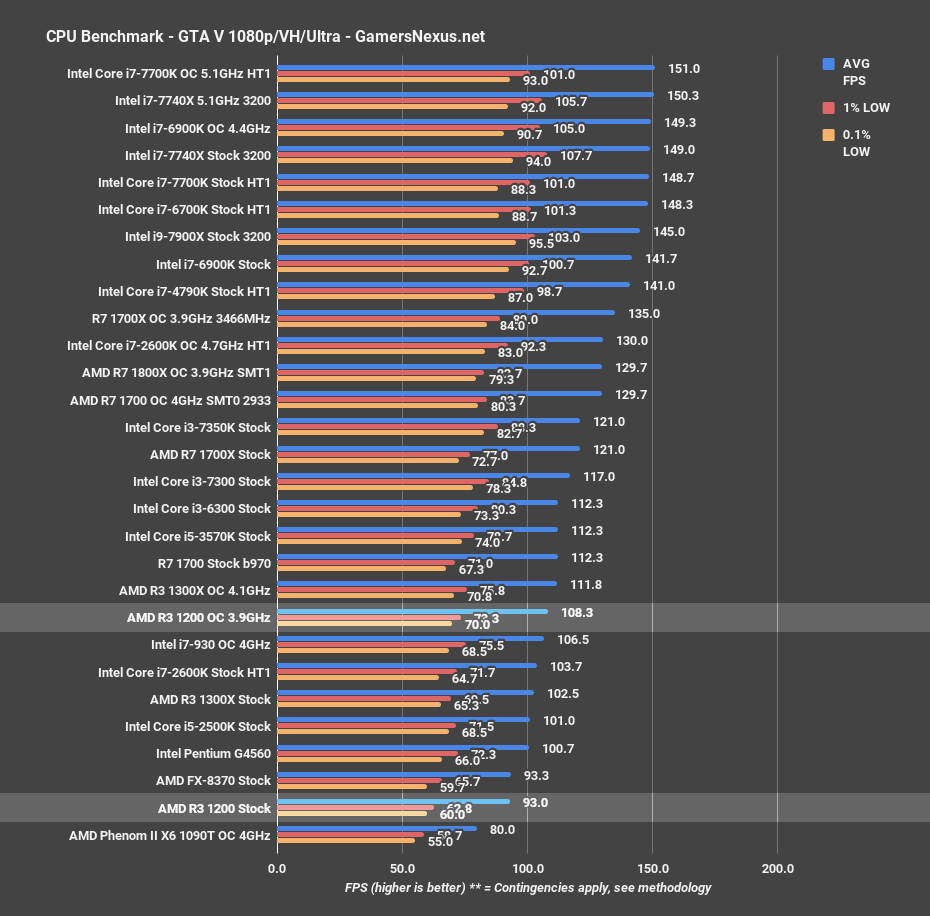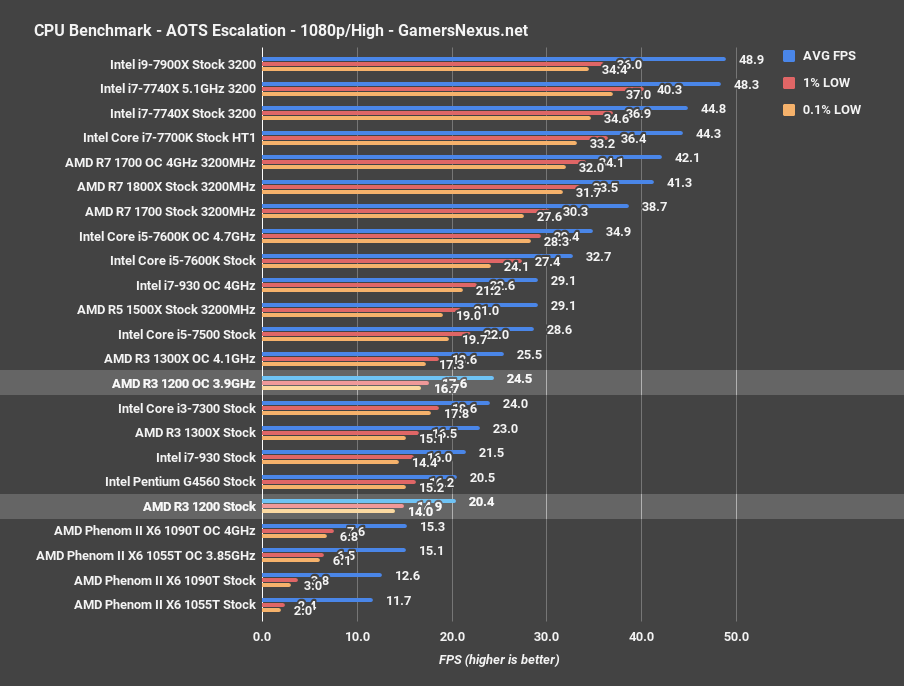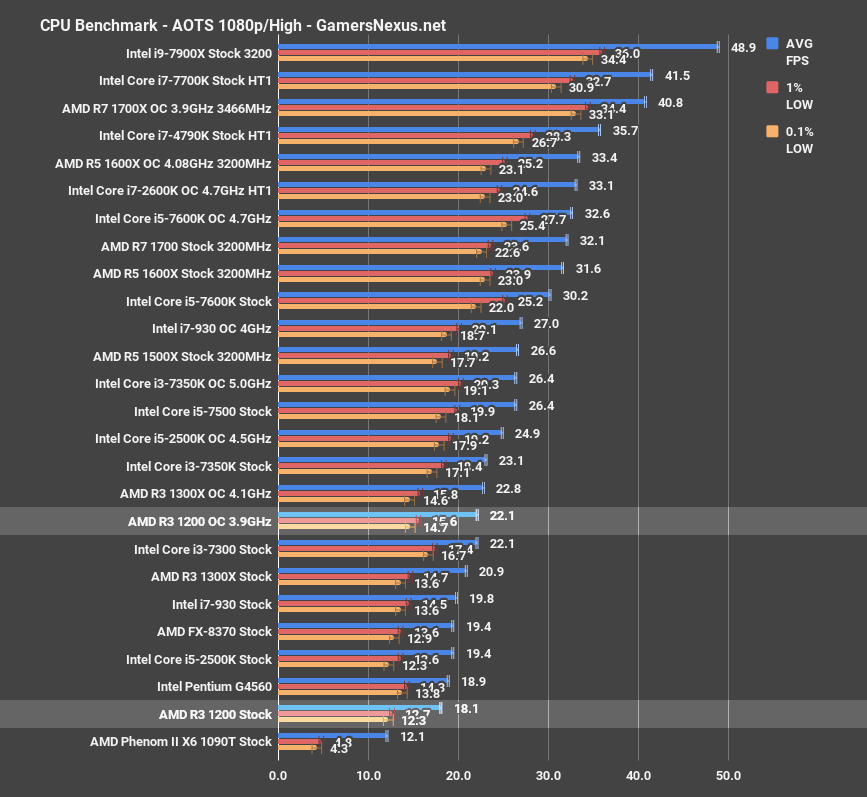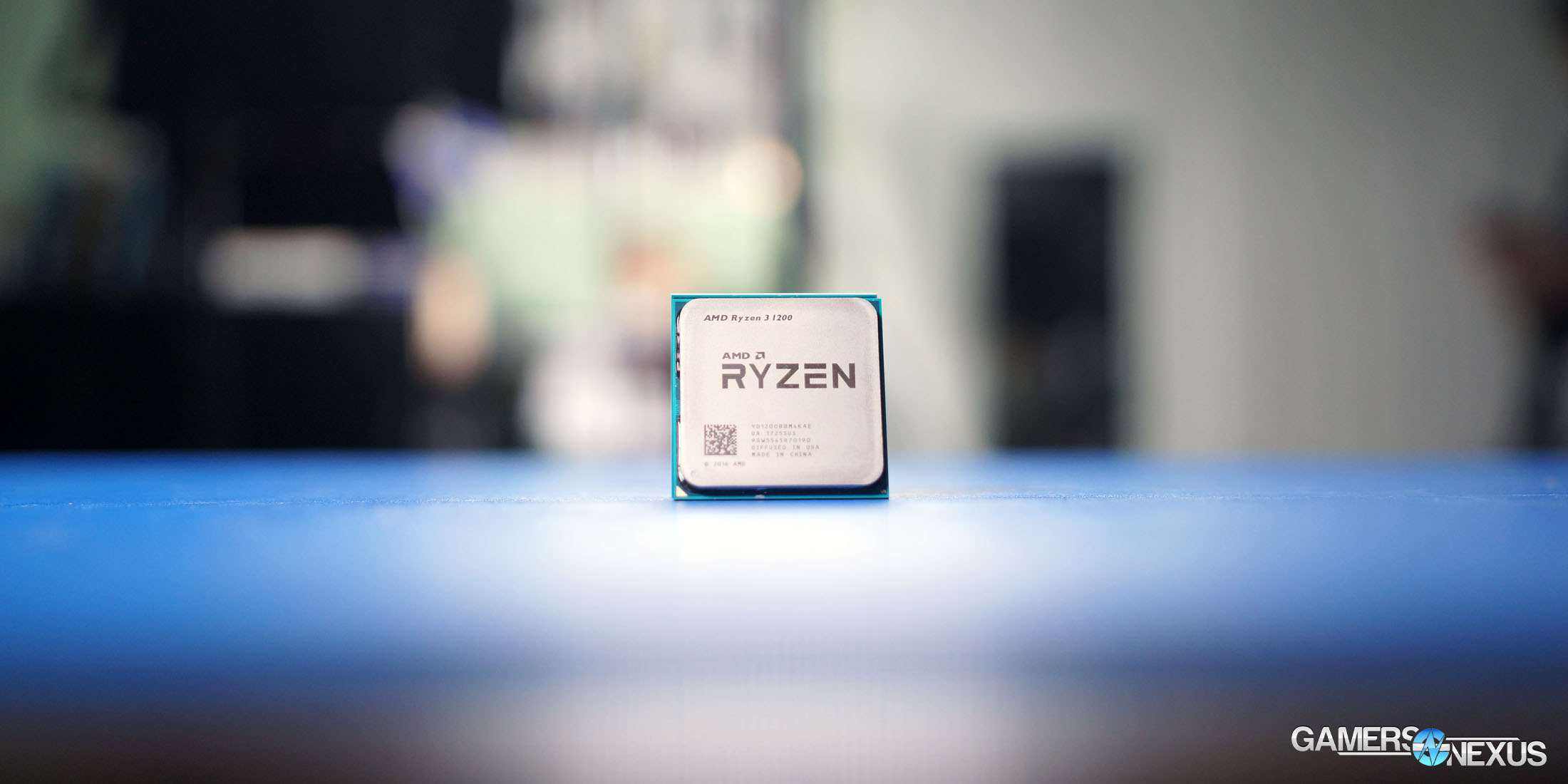AMD’s Ryzen lineup mirrors traits at both the R3 and R7 ranges, where both series of CPUs are effectively the same inter-lineup, but with different clock speeds. The R7 CPUs largely all clock to about the same area (+/-200MHz) and consist of the same features. The same can be said for the two R3 SKUs – the R3 1200 and R3 1300X – where the CPUs are functionally identical outside of frequency. This means that, like with the R7 1700, the R3 1200 has potential to challenge and replace the 1300X for users willing to overclock. Remember: A basic overclock on this platform is trivial and something we strongly encourage for our audience. The cost savings are noteworthy when driving an R7 1700 up to 1700X or 1800X levels, and the same can likely be said about the R3 1200.
That’s what we’re finding out today, after all. Our R3 1200 review follows the review of the 1300X and aims to dive into gaming performance, overclocking performance, production applications, and power consumption. Nearby CPUs of note include the 1300X, the Pentium G4560, the R5 series CPUs, and the i3 CPUs.
AMD’s R3 1200 is a $110 part, making it $20 cheaper than the R3 1300X and significantly cheaper than both the i5 and R5 CPUs. Frequency is also down: The R3 1200 clocks at 3.1GHz base / 3.4GHz boost on its 4C/4T design, lower than the R3 1300X that we just reviewed.
CPU Test Methodology
Windows 10 b970 was used for testing. R7 CPUs have been retested; some i7 & i5 CPUs have been retested. Game settings were manually controlled for the DUT. All games were run at presets defined in their respective charts. All other game settings are defined in respective game benchmarks, which we publish separately from GPU and CPU reviews. We are testing with the latest BIOS and AGESA on the C6H.
Average FPS, 1% low, and 0.1% low times are measured. We do not measure maximum or minimum FPS results as we consider these numbers to be pure outliers. Instead, we take an average of the lowest 1% of results (1% low) to show real-world, noticeable dips; we then take an average of the lowest 0.1% of results for severe spikes.
Hardware Used
Core Components (Unchanging)
- NZXT 1200W Hale90v2
- For DDR4 platforms: Corsair Vengeance LPX 32GB 3200MHz*
- For Ryzen DDR4: Corsair Vengeance LPX 3000MHz clocked to 2933MHz (See Page 2)
- Premiere & Blender tests do not exceed 8GB DRAM. Capacity is a non-issue for our testing, so long as it is >16GB
- For DDR3 platforms: HyperX Savage 32GB 2400MHz
- Intel 730 480GB SSD
- Open Air Test Bench
- Cooler #1 (Air): Be Quiet! Dark Rock 3
- Cooler #2 (Cheap liquid): Asetek 570LC w/ Gentle Typhoon fan
- Cooler #3 (High-end): Kraken X62 for all performance tests
- EVGA GTX 1080 FTW1
Note: fan and pump settings are configured on a per-test basis.
AM4 Platform:
- GEIL X 3200MHz CL16 (R5s, R7 1700, R7 1800X)
- GSkill Trident Z 3200MHz CL14 (R7 1700X)
Used for R7 1800X, R7 1700X, R7 1700.
Z270 Platforms:
- Gigabyte Aorus Gaming 7 (primary)
- MSI Gaming Pro Carbon (secondary - for thermal validation)
- i7-7700K (x2) samples from motherboard vendors
Both used for the 7700K.
Z170 Platform:
- MSI Gaming M7
- i7-6700K retail
Z97 Platform:
- Gigabyte Z97X G1 WIFI-BK
- i7-4790K
Z77 Platform:
- MSI GD65 Z77
- i7-2600K
Dx12 games are benchmarked using PresentMon onPresent, with further data analysis from GN-made tools.
Note: We'd like to add the i5, i3, and FX CPUs, but this was enough for now. We'll add those as we expand into coverage of Zen or i5 Kaby Lake products.
Continue to the next page for Blender, Premiere, Cinebench, and synthetics.
Blender CPU Benchmark – R3 1200 vs. R5 1600X, G4560, etc.
Blender wasn’t stable with our 3.9GHz overclock, so we stepped down to 3.8GHz for this particular test. The R3 1200 stock CPU completes the scene render in 102 minutes, so it takes 14% longer to render than the stock 1300X, and overclocking gets the CPU down to 87 minutes – about tied with the 1300X. Because we’re down to just 4C/4T on these R3 CPUs, performance here isn’t exciting. It’s not bad, as stated in our 1300X review yesterday, but it’s also just not that interesting. If rendering really is of interest, and if using a CPU for rendering is on the agenda more than infrequent intervals, we would still very strongly encourage an R5 1500X or 1600 purchase. The cost is higher, but the render times are halved as we approach overclocked R5 1600 territory. That’s a major savings in time for anyone rendering even in light freelance capacities, so it’ll recoup the loss quickly.
POVRay Benchmark – R3 1200 & R3 1300X
Cinebench R15 – R3 1200 & R3 1300X
Adobe Premiere Benchmark – AMD R3 1200 vs. R5, i7 CPUs
Premiere is more of the same as Blender. The R3 1200 stock CPU takes 198 minutes to complete the render. The overclocked 1300X – which is right where the 1200 would perform when overclocked, too – completes the render in 156 minutes. Compared to R5 CPUs in the 80 to 130-minute range, this is significantly slower. R3 CPUs really aren’t meant for these tasks, and again, we’d recommend a bump-up in tiering if rendering on the CPU is in the plans. Most of our Premiere workloads will accelerate fine on GPUs, though, so it just depends on what you’re doing.
3DMark FireStrike – AMD R3 1200 CPU Benchmark
Continue to the next page for power testing.
As a reminder from our R3 1300X review, we’ve moved on from wall meter power testing for CPU reviews. New testing methods primarily focus on EPS12V rail power testing, meaning that power consumption metrics are taken closer to the source (the CPU) at the 8pin headers from the PSU. A clamp is used to measure current pushed at 12.3v, providing the data required to accurately measure power utilization by the CPU (+/-2% error). Compared to wall testing, the level of interference from other components minimizes, and so we don’t need to worry about uncontrollable power fluctuations by items like the GPU, system fans, or auxiliary components.
Because this is new testing – like, brand new – we only have a few SKUs on the charts. Bear with us as we expand the charts to include more SKUs.
AMD R3 1200 Idle Power Consumption
Idle at the Windows 10 desktop, the R3 1200 is presently our lowest power consumption CPU at 2.5W idle consumption, followed by both the 1300X and 1700 CPUs. Overclocking the R3 1200 to 3.9GHz with a 0.1V offset gets us to 9.8W idle, followed by the 1300X at 4.0GHz.
AMD R3 1200 Blender Power Consumption
Using a real-world Blender animation project for the next test, we get a glimpse at power consumption under a 100% rendering load scenario. The R3 1200 CPU consumes 28W of power via EPS12V cables when rendering at stock settings, placing it about 32% lower than the R3 1300X; in actual render performance, as we’ll see in a moment, the difference is a 13% time reduction with the 1300X. Overclocking both pushes to 46W on the R3 1200 and 52W on the R3 1300X – both reasonably low power consumption for a part of this class, and a stark contrast from AMD’s old reputation with CPUs. It seems that the company has largely resolved its FX-era high-power reputation, which of course coincides with thermals reduced in-hand.
At the same frequencies and voltages, the CPUs draw the same power.
AMD R3 1200 3DMark FireStrike Physics Power Consumption
Moving next to FireStrike’s physics test, another real-world scenario, we see power consumption at about 27W for the R3 1200 and 44W for the overclocked variant, drawing more than the 7350K in part because of the additional physical hardware for the 4C configuration. Architecture, of course, is also vastly different between the two. The R3 1300X lands at 38W stock and 47W when overclocked. Just like with the R7 CPUs, overclocking is a great equalizer for AMD’s SKUs.
AMD R3 1200 Total War Power Consumption
Total War: Warhammer is next. The R3 1200 runs the game at 30W peak during the benchmark with the 1300X stock CPU at 41.8W. The overclocked variants draw 49W and 54W, respectively. Again, we’re well within reasonable power consumption metrics for parts of these specs.
AMD R3 1200 Cinebench Power Consumption
AMD R3 1200 Prime95 28.5 LFFT Power Consumption
Finally, Prime95 28.5 gives a more torturous workload and lands the R3 1200 at 41W, with the 1300X consuming 39% more at 57W. Overclocking increases power consumption on the R3 1200 by 48%, landing at 60W and near the R3 1300X at 64W.
Continue to the next page for gaming performance on the R3 1200.
AMD R3 1200 Gaming Performance Benchmarks
As ever, we look at components primarily from the perspective of a value argument. Gaming performance drives this argument best, as that’s where buyers tend to care most about value proposition mapped to performance. The AMD R3 CPUs instantly land themselves in a particular class of CPU that’s budget-targeted, given the price, and so map most adequately versus existing i3 and Pentium parts. Ultimately, we do draw some comparisons upward and toward the R5 series – it’s not a far stretch, and production performance bolsters tremendously – but go no further than that in text. We’re assuming that most buyers of R3-class parts are likely not interested in an R7 or i7 CPU. The numbers are still present in the charts, though.
Total War: Warhammer Benchmark – AMD R3 1200 vs. 1300X, G4560, i3, i5
Starting with Total War: Warhammer with High settings, the R3 1200 CPU performs at 109FPS AVG, with 1% LOWs at 65.8FPS and 0.1% LOWs at 59FPS. This ties the R3 1200 with the nigh-unattainable but highly desirable Pentium G4560, which may as well be a processor of myth at this point. The G4560 runs roughly the same framerate across the board, though its numbers were entered prior to the latest Total War update, and so you could expect a slight uptick in performance. Regardless, this gives us an accurate depiction of how both CPUs perform.
Unlike the G4560, however, the 1200 overclocks. With a 3.9GHz OC, we jump to 127FPS AVG on the R3 1200, for an improvement of 15.7% over the stock 1200 CPU. This also puts us pretty damn close to the 1300X when overclocked to 4.1GHz, at 129FPS AVG, and the difference ultimately comes down to frequency. Our 1200 got stuck at 3.9GHz, but just like the R7 CPUs, equal clocks would provide equal performance, here. This makes the R3 1200 a much better value for anyone willing to overclock, as you save $20 right away and can achieve the same performance once clocked higher.
The Intel i3-7300 CPU is still sold for around $150, though we’ve heard rumor of drops, and so is poor value compared to the $110 R3 1200 overclocked CPU, which performs effectively identically at 3.9GHz. That’s $40 saved with an overclock on a cheaper CPU, and makes the R3 1200 much more interesting than the R3 1300X.
Battlefield 1 CPU Benchmark – R3 1200 CPU
In Battlefield 1, the 1200 stock CPU performs about 8.4% slower than the 1300X when both are stock, at 101FPS AVG vs. 110FPS AVG, but overclocking again serves as aa great equalizer of AMD parts. The 1200 overclocked to 3.9GHz runs an AVG FPS of 115.5, effectively identical to the AVG FPS of the 1300X at 4.1GHz.
For comparison, our G4560 operates between the stock and overclocked R3 1200 entries at 112FPS AVG, with the R5 CPUs performing markedly better at 126FPS AVG minimally, or 136FPS AVG for the overclocked R5 1600X that previously won our Editor’s Choice award.
Metro: Last Light Benchmark – R3 1200 vs. 1300X
GTA V Benchmark – R3 1200
Watch Dogs 2 Benchmark – R3 1200 vs. 1300X, G4560, i3-7350K, etc.
In Watch Dogs 2, the AMD R3 1200 stock CPU performs around where the overclocked Phenom II X6 1090T does – not bad for either, given initial launch price of the 1090T, and behind the R3 1300X stock by about 9%. Overclocking the R3 1200 boosts us to 53FPS AVG, placing the 1200 OC a step beyond the Intel Pentium G4560 and a step below the Intel i3-6300 and AMD R3 1300X OC CPU.
Ashes of the Singularity: Escalation – R3 1200
Ashes of the Singularity Benchmark – R3 1200
Ashes of the Singularity positions the R3 1200 stock CPU about equal with the Intel Pentium G4560, but otherwise predictably at the bottom of our current-gen listings. Overclocking bolsters performance significantly, however, jumping framerate by 22.1% to tie the i3-7300 CPU and follow the 1300X overclocked CPU.
Conclusion: AMD R3 1200 - Not Bad, Not Exciting
The R3 1200 is in a significantly more advantaged position than the 1300X, and continues the interesting trend AMD has going with its stack. Just like with the R7 series, it seems most wise to purchase the lower-tier unit of the R3 CPUs – as they are both 4C/4T parts, unlike the more thread-mixed R5 parts – and then opt for an overclock. Overclocking these CPUs is trivial, and we strongly encourage the couple-minute venture to push to at least 3.8GHz on the R3 1200. Performance uplift is noteworthy and matches the 1300X equivalently, but with the same price.
As for gaming performance, well, it’s an interesting position. The R3 1200 at $110 is competitive – there’s no doubt about that. The i5 CPU proposition is already threatened by AMD’s R5 1600 series CPUs in significant ways, and the i3 CPUs have long been cannibalized by Intel’s own Pentium series.
The Pentium series still exists in the sub-$100 class, and still performs excellently in the games we’ve tested. We previously ran a GPU bottlenecking test and found that the G4560 pairs well with GPUs up to 1060 or 570 class hardware. That hasn’t changed, and the G4560 remains our go-to for ultra-budget builds. The R5 1600X CPU still remains our top choice between the i5 and R5 class, so that leaves a gap between the G4560 and the R5 CPUs. The R3s kind of fill it, but the performance isn’t as exciting as the R5 CPUs. It’s not bad, just to be very clear: Saying something “isn’t exciting” is not synonymous with saying it is “bad” or an unworthy purchase, and anyone thinking otherwise may need to temper the expectations a bit. To say something is adequate is not insulting in and of itself, but we also don’t need to feign excitement for a product which is just, well, adequate. It’s fine. The R3 1200 is certainly far more interesting than the 1300X, in our eyes, and overclocks to become a competitive performer at the price. The CPU does well in testing and is positioned competitively in the market, largely invalidating the 1300X when overclocking is permitted. It also isn’t so good as to drive sales away from the G4560 in ultra-budget machines, nor to convince users to step down from an R5 purchase. Just like in the 1300X review, we’re still recommending the R5 CPUs as the preferred option. If the monetary gap can be bridged – a lunch skipped, a game unpurchased – then it’s well worth the step to R5 territory.
But these are “fine,” and that’s about all there is to it.
Editorial, Test Lead: Steve Burke
Test Technician: Patrick Lathan
Video Producer: Andrew Coleman
